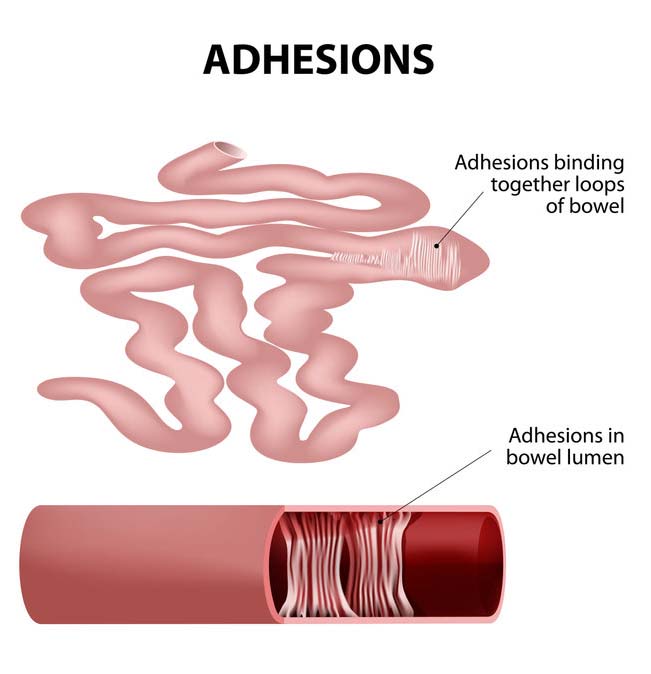
Treating Abdominal Adhesions With Myofascial Release
What is Scar tissue?
In order to understand abdominal adhesions, we must first understand scar tissue.
Scar tissue is formed by collagen. After an injury, your body lays down collagen. The collagen cells are placed near the injured tissue in a random fashion, and this leads to scar tissue. (Normal healthy collagen is aligned in specific ways and directions that give your tissue strength.)
There are many instances in the body where scar tissue will develop. Such as after surgery, after a tissue tear, after a fracture, or after an inflammatory event has taken place on any body part.
Scar tissue itself is the body’s normal method for healing body parts that are injured.
After it forms and healing has taken place, the scar needs to be remodeled so that it can tolerate the stress and forces that the body may encounter throughout each day. The remodeling process is essential to ensure that normal range of motion, strength, and mobility is restored to the injured tissue. Failure for scar tissue to remodel properly can lead to loss of mobility, joint contractures and adhesions.
What are Adhesions?
Adhesions are bands of scar-like tissue. Normally, internal tissues and organs have slippery surfaces so they can shift easily as the body moves. Adhesions cause restrictive tissues and organs to stick together. They might connect the loops of the intestines to each other, to nearby organs, or to the wall of the abdomen.
Adhesions can occur anywhere in the body. But they often form after surgery on the abdomen. Almost everyone who has surgery on the abdomen gets adhesions. Some adhesions don’t cause any problems. But when they partly or completely block the intestines, they cause symptoms such as
- Severe abdominal pain or cramping
- Vomiting
- Bloating
- An inability to pass gas
- Constipation
What Causes Abdominal Scarring
Abdominal scar tissue can be very painful as well as interfere with normal organ and systems function. Some examples of it are:
- Lower abdominal and pelvic surgeries and C-Sections carry a greater adhesion risk, and these scars can get bigger and harden up over time.
- For women, scar tissue can also lead to fertility problems. If adhesions restrict the fallopian tube, they can prevent fertilized eggs from reaching the uterus, and they increase the risk of ectopic pregnancy.
- Sometimes, abdominal adhesions can cause the intestines to twist, similar to how a garden hose can become kinked. This condition can occur shortly after, or even years after surgery and can lead to complete or partial intestinal obstruction, also called small bowel obstruction. Intestinal adhesions cause about 60% of small bowel obstructions in adults and are believed to contribute to the development of chronic pelvic pain.
Abdominal adhesions can pull sections of the intestines out of place or restrict their movement. In extreme circumstances, abdominal adhesions can completely block part of the intestine and may block food from passing through the intestine.
There are no tests available to detect adhesions. Instead, if a patient exhibits the types of pain listed above or other abdominal symptoms, a doctor will perform a laparoscopy to detect any abdominal adhesions. Usually, adhesions are found during exploratory surgery to determine the cause of the pain or during surgery to correct a different problem.
Can Myofascial Release Help with Abdominal Adhesions?

When a patient seeks myofascial release therapy for abdominal pain, they have either already had surgery (which caused the problems) or they are seeking alternative treatment options for their pain.
Myofascial Release (MFR) has been used to manage scar tissue and the adhesions that occur in the abdominal area.
Myofascial release therapy can be administered to the abdomen, diaphragm and all involved areas to reduce abdominal adhesions, help remodel scar tissue and allow the digestive and reproductive systems to function optimally.
The technique involves using the hands to release the restrictions on underlying tissues around the scar. Motions are gentile and the amount of force used is usually light, applied for a sustained time. Your Myofascial Release Practitioner can feel for restrictions of tissue, in various directions and work to improve movement in those restricted directions.
After an injury, scar tissue can be formed as part of the natural healing process. However, sometimes, scar tissue can restrict the movement of fascia, and soft tissue in general, and cause pain. Myofascial release helps loosen scar tissue and helps restore normal function of the tissue in the abdomen area.
“Carolina is amazing. She is very knowledgeable and thorough in her exam and treatment. She has helped me heal from an injury and given me exercises to do to help keep me healthy. As an ICU nurse, my job is very physically demanding and I’m grateful to her for helping to keep me up and running. I would recommend her without hesitation!”
Rosemary C.
Myofascial Release is an effective treatment option if you are experiencing abdominal pain and think you having adhesions or abdominal scarring. We’ve helped many patients who almost gave up on having any relief from abdominal pain.
Are you ready to live pain-free?
FREE 15 MINUTE PHONE CONSULT
Want to see if I’m a good fit for you?
Set up a FREE 15-minute phone consultation so we can chat.
No pressure. Honestly.